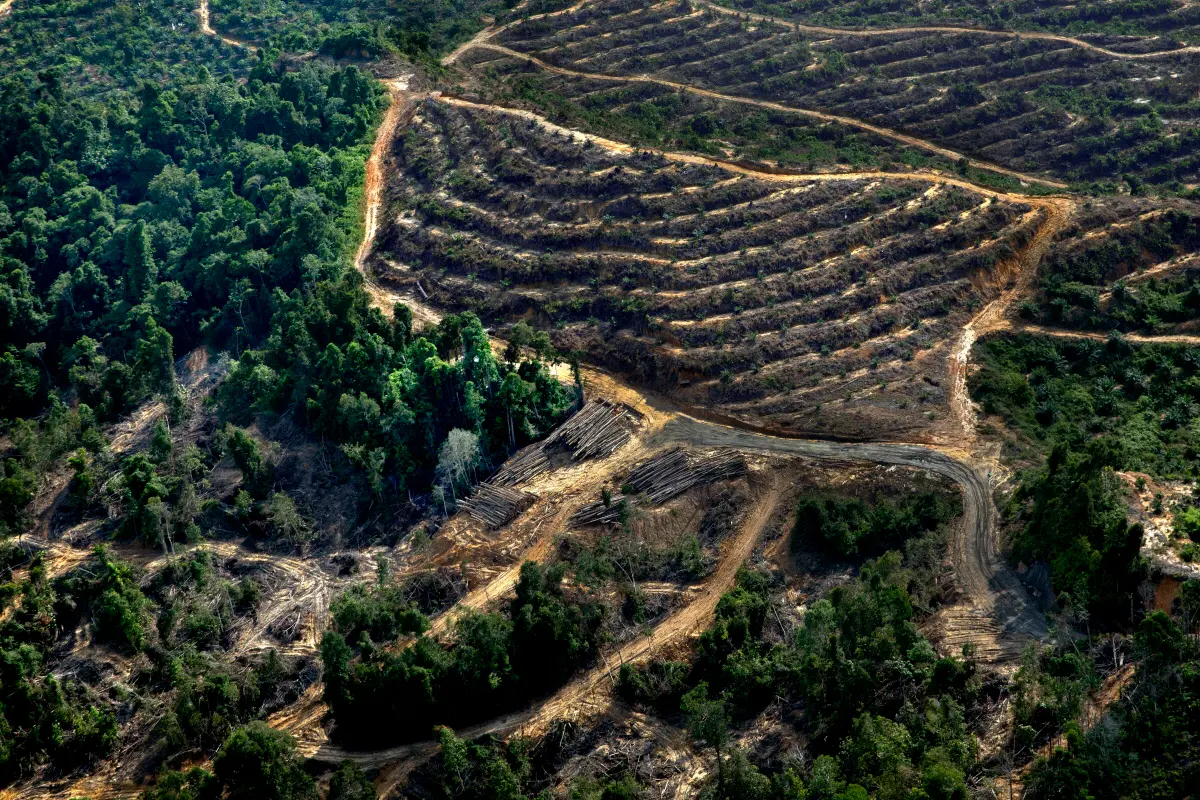
Forests: primary forest loss stays at low levels in both Indonesia and Malaysia
Insight from the latest update of the GFR’s Forest Pulse: Indonesia is the top country for the reduction in primary forest loss as of 2022, with a sixty-four percent reduction
The last two decades of tropical forest loss in Indonesia
In the past couple of decades, the forests of Indonesia have been facing challenges due to deforestation.
Twentynine-point-four Mha of tree cover was lost in Indonesia between 2001 to 2022, marking an eighteen percent tree cover decrease since the year 2000. Between 2001 and 2022, the country lost two-point-eighty-seven Mha of tree cover due to fires. The Indonesian provinces of Riau and Kalimantan Barat, also known as West Kalimantan, are Indonesia’s top areas for tree cover loss.
How much forest loss has Malaysia witnessed this century?
Malaysia lost two-point eighty-five Mha of humid primary forest between 2002 and 2022, accounting for thirty-three percent of the country’s overall loss of tree cover during that time. During this time, the country’s humid primary forest lost eighteen percent of its total area.
The Malaysian states of Sarawak and Sabah, both located on the island of Borneo, are the regions where between 2001 and 2022, fifty-six-percent of all tree cover loss took place.
While deforestation, the permanent removal of the forest led by agriculture or urbanization, isn’t the sole driver of tree cover loss, it does play a significant role. According to GFW, from 2001 to 2022, ninety-five percent of the tree cover in this Southeast Asian country was lost in places where deforestation was the chief cause of this loss.
The phenomenon of forest loss: a threat to tackle
The world would have looked much greener 10.000 years ago. About half of the forests that covered half of the planet at that time have since then been destroyed.
Since the beginning of the twenty-first century, the planet has been losing 459 million hectares (Mha) of tree cover. The world has witnessed an increase in the trend of tree cover loss going from the thirteen-point-four Mha of tree cover loss in 2001 to twenty-two-point-eight Mha in 2022.
Activities related to forestry in tree plantations or managed forests, commodity-driven deforestation linked to agriculture, oil, and gas production and mining, burning vegetation due to wildfires, shifting agriculture, and urbanization are the factors behind tree cover loss.
Forest loss across Europe
The influence of these factors on tree cover loss varieties across the world regions. In Europe, ninety-nine percent of the tree cover loss is driven by forestry, amounting to a tree cover loss of twenty-six Mha between 2001 and 2022. The picture is different in Southeast Asia, where the primary driver of tree cover loss is commodity-driven, permanent deforestation, with fifty-seven Mha lost in the region between 2001 and 2022.
The preservation of forests across the globe is necessary for maintaining biodiversity and plays a vital role in mitigating climate change. Forests act as carbon sinks, absorbing carbon dioxide from the atmosphere, supporting millions of local livelihoods, including those of Indigenous Peoples, and helping to regulate local and regional climate.

The forests in Indonesia and Malaysia: a wealth of biodiversity
Tropical forests might make up thirty percent of global tree cover and about seven percent of the planet’s land area, but they play a much more significant role in the Earth’s health. These forests alone contain half of the planet’s carbon stored in trees and are hotspots of floral and faunal biodiversity, but they have been affected by the phenomenon of deforestation.
About fifteen percent of the planet’s tropical forests are located in Southeast Asian countries such as Indonesia and Malaysia. These two neighboring countries are home to vast forests that play a critical role in the region’s ecosystem and are known for their substantial levels of biodiversity.
The archipelagic nation of Indonesia is composed of more than 17,000 islands. With a National Biodiversity Index (NBI) of 1.000, the highest possible score, Indonesia is where between ten and fifteen percent of the globe’s documented birds, mammals, and plants and six percent of the planet’s flowering plants have their home.
Malaysia, one of the seventeen so-called megadiverse nations in the world
According to Global Forest Watch, more than half of Indonesia’s land area was covered in primary forest in 2001, amounting to a total of ninety-three-point-eight Mha. Composed of two noncontiguous regions, Malaysia is one of the seventeen so-called megadiverse nations and the twelfth most biodiverse country in the world, with a NBI of 0.809.
With year-round rainfall and a tropical climate, Malaysia is home to a biodiverse rainforest. Global Forest Watch estimates show there were twenty-point-tree Mha of natural forest on Malaysian soil in 2010, covering more than eighty-seven percent of the Southeast Asian Country’s land area.
The loss of tropical forests in numbers: The Forest Pulse
World Resources Institute (WRI)’s Global Forest Review (GFR) is an online report monitoring the state of our forests through geospatial data derived from satellite imagery.
The Forest Pulse, a project by this organization, employs each year updated research and data to identify the most recent developments in global forest loss and deforestation and provides a perspective of where forests have been lost globally by employing data on annual tree cover loss.
The Forest Pulse focuses on tropical primary forests. The tropical ecozone is where half of the global tree cover loss has happened in the twenty-first century, and it’s where more than ninety-six percent of the deforestation or permanent forest removal happens.
The Forest Pulse 2023 update
Through the Glasgow Leaders’ Declaration on Forests and Land Use (GDFLU), launched at the 2021 United Nations Climate Change Conference (COP26), the leaders of 145 countries covering a total of 3,691,510,640 hectares of forest committed to “working collectively to halt and reverse forest loss and land degradation by 2030 while delivering sustainable development and promoting an inclusive rural transformation”. The following year though, was less than promising for the forests in the Tropics.
What happened to the forests in 2022?
In fact, last year, tropical primary forest loss worsened, with primary rainforest loss in the tropics increasing by ten percent in 2022 compared to 2021. In 2022, primary rainforests lost eleven eleven soccer fields worth of forest each minute. The Tropical primary forest loss in 2022 amounted to a total of four-point-one million hectares, resulting in two-point-seven Gt of CO2 emissions. The same as India’s annual fossil fuel emissions.
During the last year of Bolsonaro’s presidency, Brazil experienced a fifteen percent increase in its rate of primary forest loss, while the Brazilian part of the Amazon rainforest hadn’t witnessed such a high rate of non-fire-related loss since the year 2005. With a primary forest loss by area in 2022 of forty-three-point-one percent, the South-American country was by far the nation witnessing the biggest loss of tropical primary forests.
In 2022, both the countries of Ghana in West Africa and Bolivia in central South America experienced a record-high level of primary forest loss. In 2022, total global tree cover loss decreased by ten percent, with Russia seeing a decline of its tree cover loss amounting to thirty-four percent between 2021 and 2022, the highest tree cover loss recorded in this time span outside the tropical zone.
Primary forest loss in 2022 in Malaysia remained low
In the Southeast Asian country, non-fire related primary forest loss piqued in 2012 at zero-point-twenty-four million hectares. Annual rates started declining in 2017, and since 2020 they have stayed stable at zero-point-seven million hectares.
With a decrease in primary forest loss of fifty-seven percent, Malaysia is the fourth country for the reduction in primary forest loss as of 2022, behind Indonesia, Costa Rica, and China. The country saw a primary forest loss by area of zero-point-seven percent in 2022.
The Malaysian government has in recent years made some steps to protect its forests, including a plantation area cap and the National Forestry (Amendment) Bill 2022, which was passed by the Dewan Rakyat, the lower house of the Malaysian bicameral Parliament, in the titular year. This bill includes stricter supervision over the country’s permanent forest reserves (PFRs) and stronger penalties for illegal logging.
WRI
Established in 1982, the World Resources Institute (WRI) is a global research non-profit organization.







